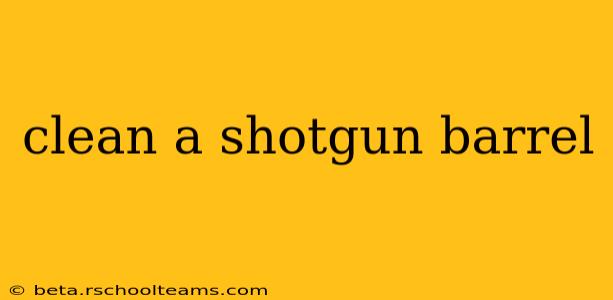Maintaining your shotgun's barrel is crucial for its longevity, performance, and your safety. A clean barrel ensures reliable function, prevents malfunctions, and extends the life of your firearm. This comprehensive guide will walk you through the process of effectively cleaning your shotgun barrel, covering everything from necessary tools to proper techniques.
Why Clean Your Shotgun Barrel?
Regular cleaning is paramount for several reasons:
- Improved Reliability: Residue from gunpowder, shot, and wadding can build up, causing malfunctions like jams or misfires. A clean barrel ensures smooth operation.
- Accuracy Enhancement: Buildup can affect the accuracy of your shots. A clean barrel promotes consistent performance.
- Extended Barrel Life: Corrosion and pitting are accelerated by residue left in the barrel. Cleaning protects your investment.
- Safety: A clean and well-maintained firearm is a safe firearm. Regular cleaning minimizes the risk of malfunctions.
Gathering Your Supplies: What You'll Need
Before you begin, gather the necessary supplies. Improper tools can damage your barrel, so invest in quality items:
- Shotgun Cleaning Rod: Choose a rod made of high-quality materials like brass or stainless steel, long enough to reach the entire barrel. Avoid using a rigid rod, as this can scratch the barrel. A flexible cleaning rod is ideal.
- Bore Brushes: These are essential for scrubbing the inside of the barrel. Get one sized appropriately for your shotgun's gauge. Multiple brushes are helpful, particularly a bronze brush for removing fouling and a nylon brush for final cleaning.
- Patches: You'll need a generous supply of cleaning patches that fit snugly inside your shotgun barrel without being too tight. Use lint-free patches to avoid leaving residue behind. Consider using different patch materials like cotton or flannel depending on the level of cleaning required.
- Gun Cleaning Solvent: Choose a solvent designed specifically for shotguns. This will help break down and remove residue effectively. Follow the solvent manufacturer’s instructions carefully.
- Gun Oil: A high-quality gun oil is necessary to lubricate and protect your barrel after cleaning.
- Cleaning Mat or Pad: Protect your work surface and keep everything organized.
- Gloves: Protect your hands from chemicals and residue.
- Eye Protection: Always wear safety glasses or goggles when handling firearms.
Step-by-Step Cleaning Process
Disclaimer: Always follow all firearm safety rules and regulations. Unloading and double-checking your firearm is paramount before cleaning.
-
Disassemble the Shotgun: Carefully disassemble your shotgun according to the manufacturer's instructions. This may involve removing the barrel, receiver, and other components.
-
Initial Cleaning: Use a bore brush and cleaning solvent to scrub the barrel thoroughly. Work from the breech to the muzzle, ensuring complete coverage. Pay attention to any stubborn residue. Repeat this process several times.
-
Patching: Once the barrel is scrubbed, use a patch attached to the cleaning rod to wipe away the loosened residue. Continue patching until the patches come out clean.
-
Final Cleaning: Use a clean patch and a small amount of gun oil to lubricate the barrel. This protects it from corrosion and ensures smooth operation.
-
Reassemble: Carefully reassemble your shotgun, ensuring all parts are properly aligned.
Maintaining Your Shotgun: Beyond Cleaning
While thorough cleaning is essential, several additional practices contribute to long-term barrel health:
- Regular Inspection: Inspect your barrel for any signs of damage or corrosion after each use.
- Storage: Store your shotgun in a cool, dry place, away from moisture.
- Proper Lubrication: Regularly lubricate moving parts, even when not cleaning the barrel thoroughly.
Cleaning your shotgun barrel is an essential part of responsible firearm ownership. Following these steps will help ensure your firearm's longevity, accuracy, and reliable performance. Remember, safety always comes first. If you are unsure about any aspect of this process, consult a qualified gunsmith.
